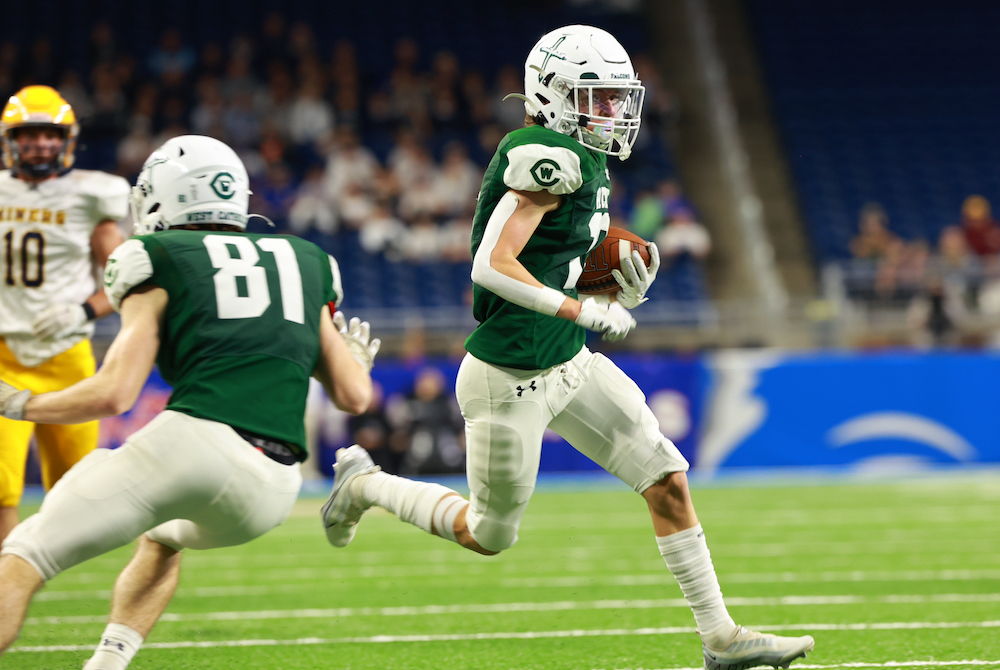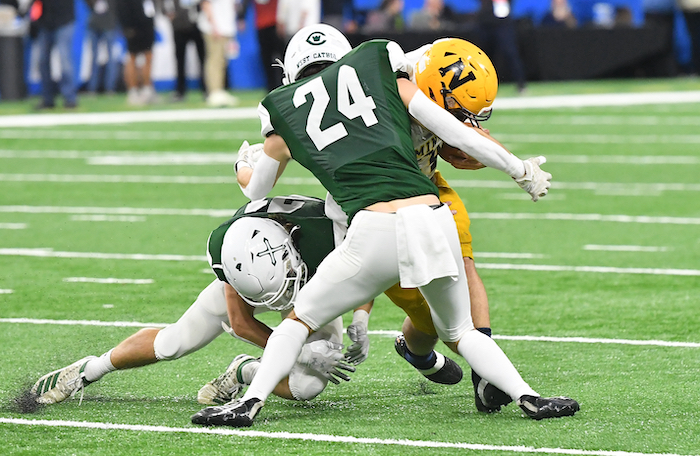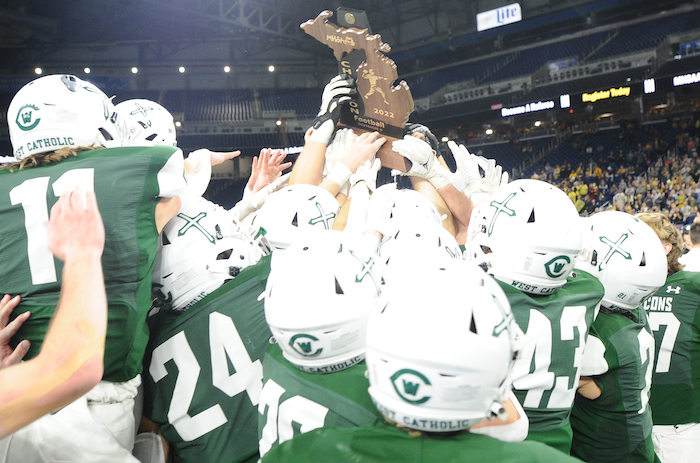
Haslett Saving Big Hits for Game Time
August 16, 2016
By Geoff Kimmerly
Second Half editor
HASLETT – The sound of cleats on pavement. He and his teammates, hand in hand, walking toward the field together minutes before kickoff. Manowar’s “Heart of Steel” ringing in their ears from a few minutes before.
 Justin Kuchnicki gave himself goose bumps Monday describing Haslett’s weekly pregame ritual, which the senior lineman will take part in again beginning Aug. 26 when the Vikings open this season against Remus Chippewa Hills.
Justin Kuchnicki gave himself goose bumps Monday describing Haslett’s weekly pregame ritual, which the senior lineman will take part in again beginning Aug. 26 when the Vikings open this season against Remus Chippewa Hills.
They’ll certainly be revved up – and especially to lay some big hits after saving them up during three weeks of non-collision practices.
Haslett has one of the most successful football programs in the Lansing area, with two trips to MHSAA championship games and 14 playoff appearances total over the last 18 seasons. The Vikings finished 6-4 a year ago against a schedule featuring four eventual playoff teams.
The program also might be the first in all of Michigan high school football to fully eliminate full-speed hitting at practice, something Haslett has moved toward over the last few seasons before longtime coach Charlie Otlewski decided to knock it out of his practice plans completely this fall in large part to keep his players healthier for when it matters most.
“It gives you the edge when it gets to game day. You practice all week and you’re not really hitting or doing anything like that, and you get to game day … and everyone’s ready to just go out there and fly around and make plays,” Kuchnicki said. “You’re not really worried about kinks and stuff in your body that you’d have from practices, so you just go out there and lay it on the line.”
Friday was the first day Michigan high school players were allowed to practice in full pads. Storms drenched mid-Michigan that afternoon, so Haslett’s first day in full gear was Monday. And from a distance, it sounded like any other full-contact practice with the normal hoots and hollers and smacking of pads.
But on closer look, it was anything but. Lineman worked against blocking dummies on a sled or teammates holding hand pads. When the offense came together to run plays, linemen blocked against overturned plastic trash barrels. On the opposite end of the field, subvarsity players worked on defensive pursuit angles but again without hitting. Under a set of uprights laid an old gymnastics mat used to soften the fall during tackling drills, which players again did against standup dummies instead of their teammates.
Reducing collisions – that is, live, game-speed, player-vs.-player hitting – remains the focus of most conversations on health and safety in football. Much of the discussion is centered on reducing concussions, and MHSAA rules changes that took effect beginning with the 2014 season limit teams to one practice per day during the preseason (when teams frequently practice twice) where collisions can take place. During the regular season, teams can have collisions during practice only two days per week.
 Otlewski – who formerly coached St. Ignace from 1990-93 before taking over at Haslett in 1994 – said his practices used to follow what could be considered a traditional after-school plan: individual position drills for an hour or more followed by 11-on-11 full contact team practice for 30-40 minutes, twice a week.
Otlewski – who formerly coached St. Ignace from 1990-93 before taking over at Haslett in 1994 – said his practices used to follow what could be considered a traditional after-school plan: individual position drills for an hour or more followed by 11-on-11 full contact team practice for 30-40 minutes, twice a week.
But a handful of reasons, chiefly the desire to avoid injuries, started his program on a different path five years ago.
“Nobody wants injuries, but you surely don’t want them in practice. Then the concussion thing started to happen. (But) we didn’t do it because of concussions; we did it because of general overall injuries,” Otlewski said.
“If we lose a guy in Thursday’s scrimmage, or next Thursday in a game, OK, that’s football. But what we don’t want to do is lose someone in practice, because that seems unnecessary.”
The initial changes Haslett began to make to practices that fall of 2011 became drastic two years later, when he and his staff went to a different practice model completely. The Vikings now break every practice into 10-minute sessions alternating between team time and position drills, so position coaches can work with players individually before and after seeing how they perform when all 11 are running plays together.
This new breakdown brought the amount of player-on-player contact at practice down significantly as much more time was dedicated to learning proper footwork, blocking and tackling techniques and other fundamentals. Players on Monday worked at 50-percent speed, at most, against teammates either in front of them and also not moving at game speed, or against others holding pads and dummies.
The last two seasons, the only full-contact session during practices came during preparation for goalline situations; Otlewski and his staff decided to eliminate those this fall as well.
“We’re OK with a certain level (of contact). But we never want to go on the ground; we always want to stay up,” he said. “We want to go fast enough so where we have to use the perfect technique to get there footwork-wise. But we’re trying to eliminate the physicality part.”
To be clear, eliminating all collisions/contact is not required by the MHSAA. And there are probably more than a few in the coaching fraternity who would think Haslett is making a massive mistake.
But the Vikings’ no-contact strategy follows a way of thinking made popular in part by coaches like Dartmouth College’s Buddy Teevens, whose team hasn’t tackled during practices in six years. The Ivy League as a whole adopted a policy of no tackling in practice for the regular season beginning this fall.
 Otlewski said teaching to tackle without contact allows his players to practice the same technique-building drills during four-player offseason workouts, his team’s no-pads summer camp and then while wearing pads during the season. His defense doesn’t face a live offense during the week, but he doesn’t think his players lose out because they can gain just as much from watching film and working on pursuit angles and recognizing formations. Same goes for his offense, which can still practice skill work and the passing game full-speed while lineman go half-speed working on footwork and blocking technique.
Otlewski said teaching to tackle without contact allows his players to practice the same technique-building drills during four-player offseason workouts, his team’s no-pads summer camp and then while wearing pads during the season. His defense doesn’t face a live offense during the week, but he doesn’t think his players lose out because they can gain just as much from watching film and working on pursuit angles and recognizing formations. Same goes for his offense, which can still practice skill work and the passing game full-speed while lineman go half-speed working on footwork and blocking technique.
And he sees 37 players on his varsity roster, with that total remaining consistent over the last many seasons – while three opponents on this year’s schedule don’t have junior varsities and a fourth won’t field a freshman team.
His players three seasons ago didn’t really like the idea of not hitting in practice at first. But they’ve since bought in. He hasn’t heard a ton from parents either way; but he taught a class on football for local moms over the winter, and they seemed to like the idea as well.
“On one hand, I’m a little apprehensive,” Otlewski said. “OK, we haven’t gone full go. Is there a difference all of a sudden when it’s live Thursday against (Grand Rapids) Christian? Are we going to be up to speed?
“I think I still worry about that a little bit. But once we get into it, it’s fine.”
Kuchnicki is just as confident. Contact doesn’t bother this guy. He’s 6-foot-6 and in the neighborhood of 320 pounds. Sure, he’d love to have one contact practice this year so he and his teammates can back up some of the trash-talking they do to each other on the field.
But he’s fine with saving his biggest hits for opponents – and especially those who might think Haslett won’t be prepared for a physical game.
“They’d probably think we’re soft,” Kuchnicki said. “But when it comes game day, they change their minds instantly. I’ll tell you that.”
 Geoff Kimmerly joined the MHSAA as its Media & Content Coordinator in Sept. 2011 after 12 years as Prep Sports Editor of the Lansing State Journal. He has served as Editor of Second Half since its creation in Jan. 2012. Contact him at [email protected] with story ideas for the Barry, Eaton, Ingham, Livingston, Ionia, Clinton, Shiawassee, Gratiot, Isabella, Clare and Montcalm counties.
Geoff Kimmerly joined the MHSAA as its Media & Content Coordinator in Sept. 2011 after 12 years as Prep Sports Editor of the Lansing State Journal. He has served as Editor of Second Half since its creation in Jan. 2012. Contact him at [email protected] with story ideas for the Barry, Eaton, Ingham, Livingston, Ionia, Clinton, Shiawassee, Gratiot, Isabella, Clare and Montcalm counties.
PHOTOS: (Top) Haslett lineman work on blocking during Monday's practice. (Middle) Vikings coach Charlie Otlewski instructs his players on one of the team's blocking schemes. (Below) Backs work on the option with barrels serving as the defensive front.

'3rd-Quarter Team' West Catholic Shows Why in Record-Setting Triumph
By
Paul Costanzo
Special for MHSAA.com
November 25, 2022
DETROIT – When Negaunee senior Phil Nelson returned the opening kickoff of the second half Friday and tied the Division 6 championship game at 14, it woke something up inside Ford Field.
Unfortunately for Negaunee, that something was Timmy Kloska.
“I just saw that kick return, and it really fired me up,” the Grand Rapids West Catholic senior running back said. “Our o-line got going, the holes were opening and we just got going.”
Kloska dominated the rest of the game, rushing for 172 yards and four touchdowns during the second half, leading West Catholic to a 59-14 victory. It was the sixth Finals title for West Catholic, and first since 2017.
The Falcons’ 59 points set the record for an 11-player Final, breaking the mark set by both Flint Powers Catholic and Saginaw Nouvel in 2011.
“It’s great,” said Kloska, who finished with 241 yards rushing for the game. “Me and all my friends, and all the players on the team, we’ve worked really hard for this. This has been a dream since we were in seventh grade, watching all those state championships. It’s a great feeling because we’ve worked so hard.”
 West Catholic put on an offensive display, gaining 520 yards of total offense and averaging 14.9 yards per play. That number sat at 16.8 yards per play entering the fourth quarter.
West Catholic put on an offensive display, gaining 520 yards of total offense and averaging 14.9 yards per play. That number sat at 16.8 yards per play entering the fourth quarter.
The Falcons had five touchdowns of longer than 30 yards, and three longer than 60. They were also remarkably balanced, as they gained 295 yards on the ground and 225 through the air on the arm of quarterback Bernie Varnesdeel.
“Our coaches, all week, have put us in good positions,” said junior receiver Carter Perry, who had touchdown receptions of 72 and 32 yards in the first half. “When you get put in that position, it’s almost easy to make the plays and execute them.”
It started right away, too, as Perry’s 72-yard score came on the first play from scrimmage.
“I knew right before the game he was going to be wide open,” Varnesdeel said. “We were working on that play all week at practice, and he’s been open most of the time. He was the main option right there, so I just hit him and executed.”
Despite the big-play success, West Catholic (13-1) wasn’t able to pull away from Negaunee because it barely had the ball during the first half.
Negaunee (13-1) had a 20:03-3:57 edge in time of possession, and ran 37 plays to West Catholic’s 13. But it took until the final play of the half for the Miners to get on the scoreboard. They scored on a 6-yard pass from Ty Jacobson to Nelson on 4th-and-goal to make it 14-7 at halftime. The scoring toss was set up by a 32-yard pass on a reverse flea flicker from Jacobson to Eli VanBuren on a third down near midfield.
“Our gameplan was really similar from the first half to the second half, but you have to give Negaunee a lot of credit,” West Catholic coach Landon Grove said. “They did a really good job. They slowed the game down. They ate up a lot of clock. That’s credit to them. They got us out of rhythm, and they kind of forced our hand a little bit by not letting us have the football.”
When Nelson ran the kick back to start the second half and tie the game at 14, it seemed as if Negaunee’s strategy was working perfectly.
 But West Catholic’s 45 unanswered points to end the game negated all of that.
But West Catholic’s 45 unanswered points to end the game negated all of that.
“We ran out of gas,” Negaunee coach Paul Jacobson said. “We played toe-to-toe with them for a half, Phil had a great return to start the second half. I don’t know if we woke a sleeping giant. It was a combination of that, and we kind of ran out of gas. Then they rolled that second half on us.”
The Falcons scored 31 points in the third quarter, and didn’t take up a lot of time in doing so.
Kloska had touchdown runs of 61, 16 and 3 yards, and Varnesdeel threw his third touchdown pass of the game, a 68-yarder to Andrew McAlary. Carson Beekman added a 31-yard field goal.
Those five drives lasted a total of 4:35.
The difference between the third quarter and the first half, however, was that the West Catholic defense was getting the Negaunee offense off the field.
“Kind of our M.O. this year has been third quarters,” Grove said. “Kind of coming out with our hair on fire and taking over games. That’s what we did again today. That’s a testament to our defensive staff for making those adjustments they needed to make. Then our kids buying into those adjustments and believing in the process.”
Kloska added a 13-yard touchdown run in the fourth quarter, while Elliot Zainea had a 26-yard touchdown run for the Falcons.
Varnesdeel was 5-of-10 passing on the night for his 225 yards and three scores. McAlary had three catches for 121 yards, and Perry had his two for 104.
Charlie DeBruyn led the West Catholic defense with 10 tackles, including 3.5 for loss, and forced a fumble.
Kai Lacar led Negaunee with 45 yards rushing, and Ty Jacobson was 7-of-12 passing for 78 yards.
“I’m just proud of these guys, the way they battled adversity,” Paul Jacobson said. “They battled a ton of different stuff this year. Just the ups and downs, they were able to stick together. We really preach a family mentality, and they stuck together through and through. I’m proud of these guys.”
PHOTOS (Top) West Catholic’s Carter Perry (13) gets upfield during his team’s Division 6 championship win. (Middle) The Falcons’ Danny Groskiewicz (24) and Joe Debski bring down a Negaunee ball carrier. (Below) West Catholic players celebrate Friday’s win. (Click for more from Hockey Weekly Action Photos.)

